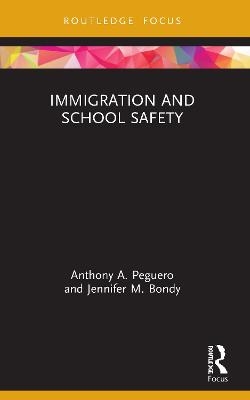
Immigration and School Safety
Routledge (Verlag)
978-0-367-74118-1 (ISBN)
A wide array of factors, including but not limited to laws, public and political discourses, educational policies, interpersonal relationships, socioeconomic status, English language proficiency, citizenship, legal status, family characteristics, race and ethnicity, generational status, nationality, religion, and gender, contribute to the marginalizing experiences of children of immigrants at school. With the rapid growth of students in immigrant families in U.S. schools, any effort to address school violence and implement school safety policies must consider barriers associated with the unique educational experiences of that segment. This book highlights the often overlooked importance of immigration as a mediating factor in explaining both violence and victimization and provides a blueprint for integrating immigration and criminology theories into evidence-based efforts toward ensuring safety for all students.
The authors demonstrate that immigration matters significantly in school violence and safety concerns and illustrate why research that integrates immigration with criminology theories is needed to understand the causes and correlates of school violence. The book will appeal to a wide array of individuals, including academics, educators, policymakers, practitioners, social workers, parents, and stakeholders who are committed to addressing educational disparities and inequities associated with immigration and school safety.
Dr. Anthony A. Peguero is Professor in the School of Criminology and Criminal Justice and the T. Denny Sanford School of Social and Family Dynamics at Arizona State University. Dr. Peguero’s research focuses on youth violence, socialization and marginalization, education, and the adaptation of the children of immigrants. Overarching themes in Dr. Peguero’s research include the barriers and challenges faced by the children of immigrants; how social inequality is central to sociological and criminological theories toward understanding and addressing youth violence; the intersection of race/ethnicity, immigration, and gender in relationship to youth marginalization, particularly within schools; and policies intended to promote safety and equity for youth. Dr. Peguero serves as the Director of the Laboratory for the Study of Youth Inequality and Justice, Research Fellow at the Institute for Society, Culture and Environment, and Research Affiliate of the Center for Peace Studies and Violence Prevention at Virginia Tech. He is also a member of the Racial Democracy, Crime, and Justice Network and co-founder of Latina/o/x Criminology, which both hold the goals of advancing research on the intersection of race, crime, and justice and promoting racial democracy within the study of these issues by supporting junior scholars from underrepresented groups. Dr. Jennifer M. Bondy is Associate Professor in the School of Social Transformation at Arizona State University. Her research focuses on three interrelated lines of inquiry: 1) Latina youth citizenship formations, 2) school socialization of the children of immigrants, and 3) the intersections of teacher education and documentation status. Dr. Bondy is Co-Director of the Laboratory for the Study of Youth Inequality and Justice. She also serves as Co-Chair for Division K: Teaching and Teacher Education, Section IV: Marginality, Equity, and Justice in PK–16 settings for the American Educational Research Association. Dr. Bondy is currently an editorial board member for the American Educational Research Journal; Race, Ethnicity and Education; Taboo: The Journal of Culture and Education; and the Journal of Curriculum and Pedagogy. Prior to becoming an academic, Dr. Bondy taught high school for four years.
Preface
Acknowledgments
Chapter 1: Introduction
Chapter 2: How Immigration Matters with School Violence and Safety
2.1: Defining School Violence and Safety
2.2: Context of Reception
2.3: "Immigrant Criminal" Myth
2.4: School to Prison/Deportation Pipeline
2.5: Social, Political, and Educational Climate of Immigration
2.6: Theories of Assimilation (Straight-Line Assimilation, Segmented Assimilation, and Immigrant Optimism)
Chapter 3: Intersecting Factors Associated with Immigration and Safety
3.1: Socioeconomic Status and Social Class
3.2: Race, Ethnicity, and Region of Origin
3.3: Gender
3.4: English-Language Proficiency
3.5: Family
3.6: Documentation Status
Chapter 4: The Significance of Criminology Theories
4.1: The School Violence "Immigrant Paradox"
4.2: The Importance of Integrating Immigration and Criminology Theories
4.3: Social-Ecology
4.4: Social Bonds
4.5: Opportunity
4.6: Minority Threat
4.7: Procedural Justice
Chapter 5: The Implications and Importance of Considering Immigration with School Safety
5.1: Educational Faculty, Staff, Administrators, and Policymakers
5.2: Zero-Tolerance and Control Approaches
5.3: Schoolwide Positive Behavioral Interventions and Support
5.4: Communal Schools
5.5: Olweus Bullying Prevention Programs
5.6: Restorative Justice in Schools
Chapter 6: Conclusion
References
| Erscheinungsdatum | 07.09.2022 |
|---|---|
| Reihe/Serie | Routledge Studies in Crime and Society |
| Verlagsort | London |
| Sprache | englisch |
| Maße | 138 x 216 mm |
| Gewicht | 453 g |
| Themenwelt | Recht / Steuern ► Strafrecht ► Kriminologie |
| Sozialwissenschaften ► Pädagogik ► Didaktik | |
| Sozialwissenschaften ► Soziologie | |
| ISBN-10 | 0-367-74118-0 / 0367741180 |
| ISBN-13 | 978-0-367-74118-1 / 9780367741181 |
| Zustand | Neuware |
| Haben Sie eine Frage zum Produkt? |
aus dem Bereich


